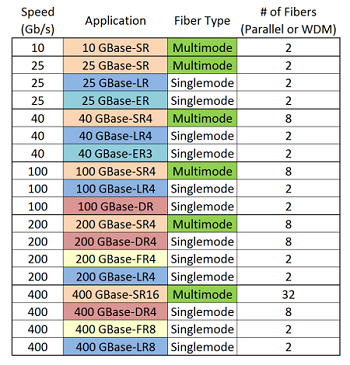All Fiber Roads Divisible by 2 and 8
June 14, 2017 / General, 101 learning, Installation and testing, Best Practices
By now you’ve probably heard of 8-fiber MPO plug and play solutions available on the market, which are ideal for Gigabit (40GBASE-SR4) and 100 Gigabit (100GBASE-SR4) applications that use 8 fibers with 4 transmitting and 4 receiving at either 10 or 25 Gb/s.
 Unlike 12-fiber MPO solutions where 4 of the 12 fibers go unused, 8-fiber MPO solutions offer 100% fiber utilization in these applications.
Unlike 12-fiber MPO solutions where 4 of the 12 fibers go unused, 8-fiber MPO solutions offer 100% fiber utilization in these applications.
But did you know that when looking ahead to future fiber applications, 8-fiber MPO solutions continue to make the most sense? That’s because all future duplex, parallel optic and WDM-based fiber applications are divisible by either 2 or 8 fibers – not 12.
From 10 to 400 Gig
When looking at current 10 Gigabit (10GBASE-SR) and 25 Gigabit (25GBASE-SR) duplex multimode fiber applications and future 50 Gigabit (50GBASE-SR) duplex fiber standards in development that transmit either 10, 25 or 50 Gb/s over each fiber, it’s easy to see why all roads lead to 2 or 8 fibers.
We already have 8-fiber 100GBASE-SR4 transmitting 25 Gb/s per fiber. Now the 50 Gb/s transmission per fiber slated for 50GBASE-SR has prompted the development of 200 Gigabit (200GBASE-SR4) over multimode where 4 fibers transmit at 50 G/bs and 4 fibers receive at 50 Gb/s.
25 and 50 Gb/s transmission also gives us the potential for 400 Gigabit over 16 fibers (transmitting at 50 Gb/s) or 32 fibers (transmitting at 25 Gb/s and currently in development as 400GBASE-SR16) – again both of which are divisible by 8, not 12.
If we look at wavelength division multiplexing technology over multimode, supported by new wide band multimode fiber (WBMMF), referred to as OM5, we still see potential future fiber applications as divisible by 2 or 8.
For example, if a WDM option over multimode that supports 25 Gb/s over four different wavelengths comes to fruition, that will open the door for 100 Gigabit over a duplex fiber connections. Extrapolating that technology to an 8-fiber MPO interface, we have the potential for 400 Gig over multimode using WDM technology – 4 fibers transmitting and 4 fibers receiving at 100 Gb/s.
And Singlemode Too
The same holds true for Singlemode. Current 40GBASE-LR4, 100GBASE-LR4 and 100GBASE-ER4 WDM-based fiber applications over singlemode use a duplex fiber. And future singlemode applications transmitting 50 Gb/s over 8 wavelengths via WDM technology still places the number of fibers at 2.
Short-reach singlemode applications in development for data center applications, including 200GBASE-DR4 and 400GBASE-DR4 transmitting and receiving at either 50 or 100 Gb/s over each fiber will also use the 8-fiber MPO interface.
12-Fiber MPO’s Future
So what does this mean for the future of the 12-fiber MPO? In reality, not much.
For those who already have 12-fiber MPO solutions in place, they will be able to support duplex applications. For 8-fiber applications, they should use conversion cords and modules to transition two 12-fiber MPOs to three 8-fiber MPOs if they don’t want unused fiber. Most new plug and play MPO deployments however will use 8-fiber solutions since this offer the most efficient, flexible option for current and future high-speed fiber applications.
The good news is that 8-fiber and 12-fiber MPO interfaces have the same footprint and are both easily tested using Fluke Networks' MultiFiber™ Pro – simply test either solution and the MultiFiber Pro displays results by scanning all fibers simultaneously, regardless of the number of fibers in the connector.






